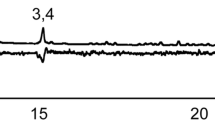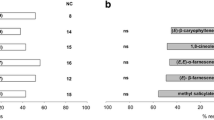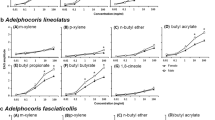Abstract
The Oriental tobacco budworm moth, Helicoverpa assulta (Guenée) (Lepidoptera: Noctuidae), is a serious pest on tobacco in China. The flowering stage of the host plant is one of the most attractive stages to H. assulta for feeding and oviposition. Nine electrophysiologically active compounds in tobacco headspace at flower stage were detected by gas chromatography–electroantennographic detection (GC–EAD). These compounds were subsequently identified by gas chromatography-mass spectrometry (GC–MS) as (E)-β-ocimene, octanal, (Z)-3-hexenyl acetate, (Z)-3-hexen-1-ol, nonanal, (Z)-3-hexenyl-2-methyl butyrate, decanal, linalool, and (E)-β-caryophyllene. The synthetic blend containing nine of the above compounds attracted mated H. assulta females from a distance by upwind oriented flight. Selected subtraction assays showed that the 4-component mixture of (E)-β-ocimene, (Z)-3-hexenyl acetate, nonanal, and (E)-β-caryophyllene elicited equivalent levels of attraction as the 9-component mixture. The removal of any of the four compounds from the 4-component blend resulted in a significant decrease in female upwind flight behavior.




Similar content being viewed by others
References
Anderson P, Hilker M, Hansson BS, Bombosch S, Klein B, Schildknecht H (1993) Oviposition deterring components in larval frass of Spodoptera littoralis (Boisd.) (Lepidoptera: Noctuidae): a behavioral and electrophysiological evaluation. J Insect Physiol 39:129–137
Ansebo L, Coracini MD, Bengtsson M, Liblikas I, Ramirez M, Borg-Karlson A-K, Tasin M, Witzgall P (2004) Antennal and behavioural response of codling moth Cydia pomonella to plant volatiles. J Appl Entomol 128:488–493
Bengtsson M, Jaastad G, Knudsen G, Kobro S, Bäckman AC, Pettersson EW, Witzgall P (2006) Plant volatiles mediate attraction to host and non-host plant in apple fruit moth, Argyresthia conjugella. Entomol Exp Appl 118:77–85
Bengtsson JM, Wolde-Hawariat Y, Khbaish H, Negash M, Jembere B, Sevoum E, Hansson BS, Larsson MC, Hillbur Y (2009) Field attractants for Pachnoda interrupta selected by means of GC-EAD and single sensillum screening. J Chem Ecol 35:1063–1076
Bichão H, Borg-Karlson A-K, Wibe A, Araújo J, Mustaparta H (2005) Molecular receptive ranges of olfactory receptor neurones responding selectively to terpenoids, aliphatic green leaf volatiles and aromatic compounds, in the strawberry blossom weevil Anthonomus rubi. Chemoecology 15:211–226
Birkett MA, Bruce TJA, Martin JL, Smart LE, Oakley J, Wadhams LJ (2004) Response of female orange wheat blossom midge, Sitodiplosis mosellana, to wheat panicle volatiles. J Chem Ecol 30:1319–1328
Boo KS, Park KC, Hall DR, Cork A, Berg BG, Mustaparta H (1995) (Z)-9-tetradecenal: a potent inhibitor of pheromone-mediated communication in the oriental tobacco budworm moth, Helicoverpa assulta. J Comp Physiol A 177:695–699
Bruce TJA, Cork A (2001) Electrophysiological and behavioral responses of female Helicoverpa armigera to compounds identified in flowers of African Marigold, Tagetes erecta. J Chem Ecol 27:1119–1131
Bruce TJA, Wadhams LJ, Woodcock CM (2005) Insect host location: a volatile situation. Trends Plant Sci 10:269–274
Burguiere L, Marion-Poll F, Cork A (2001) Electrophysiological responses of female Helicoverpa armigera (Hübner) (Lepidoptera; Noctuidae) to synthetic host odours. J Insect Physiol 47:509–514
Cha DH, Hesler SP, Moser CL, Nojima S, Linn CEJ, Roelofs WL, Loeb GM (2008a) Flight tunnel responses of female grape berry moth (Paralobesia viteana) to host plants. J Chem Ecol 34:622–627
Cha DH, Nojima S, Hesler SP, Zhang AJ, Linn CEJ, Roelofs WL, Loeb GM (2008b) Identification and field evaluation of grape shoot volatiles attractive to female grape berry moth (Paralobesia viteana). J Chem Ecol 34:1180–1189
Cork A, Boo KS, Dunkelblum E, Hall DR, Jee-Rajunga K, Kehat M, Jie EK, Park KC, Tepgidagarn P, Liu X (1992) Female sex pheromone of oriental tobacco budworm, Helicoverpa assulta (Gueflee) (Lepidoptera: Noctuidae): Identification and field testing. J Chem Ecol 18:403–418
Cunningham JP, Moore CJ, Zalucki MP, Cribb BW (2006) Insect odour perception: recognition of odour components by flower foraging moths. Proc R Soc B 273:2035–2040
Fitt GP (1989) The ecology of Heliothis species in relation to agroecosystems. Ann Rev Entomol 34:17–52
Fraser AM, Mechaber WL, Hildebrand JG (2003) Electroantennographic and behavioral responses of the sphinx moth Manduca sexta to host plant headspace volatiles. J Chem Ecol 29:1813–1833
Hartlieb E, Rembold H (1996) Behavioral response of female Helicoverpa (Heliothis) armigera HB. (Lepidoptera: Noctuidae) moths to synthetic pigeonpea (Cajanus cajan L.) kairomone. J Chem Ecol 22:821–837
Hern A, Dorn S (1999) Sexual dimorphism in the olfactory orientation of adult Cydia pomonella in response to α-farnesene. Entomol Exp Appl 92:63–72
Hern A, Dorn S (2004) A female-specific attractant for the codling moth, Cydia pomonella, from apple fruit volatiles. Naturwissenschaften 91:77–80
Jallow MF, Zalucki MP, Fitt GP (1999) Role of chemical cues from cotton in mediating host selection and oviposition behaviour in Helicoverpa armigera (Hübner) (Lepidoptera: Noctuidae). Aust J Entomol 38:359–366
Light DM, Knight AL, Henrick CA, Rajaska D, Lingren B, Dickens JC, Reynolds KM, Buttery RG, Merrill G, Roitman J, Campbell BC (2001) A pear-derived kairomone with pheromonal potency that attracts male and female codling moth, Cydia pomonella (L.). Naturwissenschaften 88:333–338
Loughrin JH, Hamilton-Kemp TR, Andersen RA, Hildebrand DF (1990) Headspace compounds from flowers of Nicotiana tabacum and related species. J Agric Food Chem 38:455–460
Ming QL, Yan YH, Wang CZ (2007) Mechanisms of premating isolation between Helicoverpa armigera (Hübner) and Helicoverpa assulta (Guenée) (Lepidoptera: Noctuidae). J Insect Physiol 53:170–178
Mustaparta H, Angst ME, Lanier GN (1979) Specialization of olfactory cells to insect- and host-produced volatiles in bark beetle Ips pini (Say). J Chem Ecol 5:109–123
Natale D, Mattiacci L, Pasqualini E, Dorn S (2004) Apple and peach fruit volatiles and apple constituent butyl hexanoate attract female oriental fruit moth, Cydia molesta, in the laboratory. J Appl Entomol 128:22–27
Nojima S, Linn C, Morris B, Zhang AJ, Roelofs WL (2003) Identification of host fruit volatiles from hawthorn (Crataegus spp.) attractive to hawthorn-origin Rhagoletis pomonella flies. J Chem Ecol 29:321–336
Olsson P-O, Anderbrant C, Löfstedt C, Borg-Karlson A-K, Liblikas I (2005) Electrophysiological and behavioral responses to chocolate volatiles in both sexes of the pyralid moths Ephestia cautella and Plodia interpunctella. J Chem Ecol 31:2947–2961
Raguso RA, Schlumpberger BO, Kaczorowski RL, Holtsford TP (2006) Phylogenetic fragrance patterns in Nicotiana sections Alatae and Suaveolentes. Phytochemistry 67:1931–1942
Reisenman CE, Christensen TA, Francke W, Hildebrand JG (2004) Enantioselectivity of projection neurons innervating identified olfactory glomeruli. J Neurosci 24:2602–2611
Riffell JA, Lei H, Christensen TA, Hildebrand JG (2009) Characterization and coding of behaviorally significant odor mixtures. Curr Biol 19:335–340
Rojas JC (1999) Electrophysiological and behavioral responses of the cabbage moth to plant volatiles. J Chem Ecol 25:1867–1883
Røstelien T, Stranden M, Borg-Karlson AK, Mustaparta H (2005) Olfactory receptor neurons in two Heliothine moth species responding selectively to aliphatic green leaf volatiles, aromatic compounds, monoterpenes and sesquiterpenes of plant origin. Chem Senses 30:443–461
Schoonhoven LM, Van Loon JJA, Dicke M (2005) Insect-plant biology. Oxford University Press, Oxford
Skiri HT, Stranden M, Sandoz JC, Menzel R, Mustaparta H (2005) Associative learning of plant odorants activating the same or different receptor neurones in the moth Heliothis virescens. J Exp Biol 208:787–796
Stranden M, Liblikas I, König WA, Almaas TJ, Borg-Karlson AK, Mustaparta H (2003a) (−)-Germacrene D receptor neurones in three species of heliothine moths: structure-activity relationships. J Comp Physiol A 189:563–577
Stranden M, Røstelien T, Liblikas I, Almaas TJ, Borg-Karlson AK, Mustaparta H (2003b) Receptor neurones in three heliothine moths responding to floral and inducible plant volatiles. Chemoecology 13:143–154
Sugie H, Tatsuki S, Nakagaki S, Rao CBJ, Yamamoto A (1991) Identification of the sex pheromone of the oriental tobacco budworm. Heliothis assulta (Guenée) (Lepidoptera: Noctuidae). Appl Entomol Zool 26:151–153
Tasin M, Anfora G, Ioriatti C, Carlin S, Cristofaro ADE, Schmidt S, Bengtsson M, Versini G, Witzgall P (2005) Antennal and behavioral responses of grapevine moth Lobesia botrana females to volatiles from grapevine. J Chem Ecol 31:77–87
Tasin M, Bäckman A, Bengtsson M, Ioriatti C, Witzgall P (2006a) Essential host plant cues in the grapevine moth. Naturwissenschaften 93:141–144
Tasin M, Bäckman A, Bengtsson M, Varela N, Ioriatti C, Witzgall P (2006b) Wind tunnel attraction of grapevine moth females, Lobesia botrana, to natural and artificial grape odour. Chemoecology 16:87–92
Tasin M, Bäckman A, Coracini M, Casado D, Ioriatti C, Witzgall P (2007) Synergism and redundancy in a plant volatile blend attracting grapevine moth females. Phytochemistry 68:203–209
Ulland S, Lan E, Borg-Karlson A-K, Mustaparta H (2006) Discrimination between enantiomers of linalool by olfactory receptor neurons in the cabbage moth Mamestra brassicae (L.). Chem Senses 31:325–334
Wang CZ, Dong JF (2001) Interspecific hybridization of Helicoverpa armigera and H. assulta (Lepidoptera: Noctuidae). Chinese Sci Bull 46:490–492
Wei JN, Zhu J, Kang L (2006) Volatiles released from bean plants in response to Agromyzid flies. Planta 224:279–287
Wibe A (2004) How the choice of method influence on the results in electrophysiological studies of insect olfaction. J Insect Physiol 50:497–503
Williams L, Blackmer JL, Rodriguez-Saona C, Zhu S (2010) Plant volatiles influence electrophysiological and behavioral responses of Lygus hesperus. J Chem Ecol 36:467–478
Wu ZR (1990) Oriental tobacco budworm. In: Wu FZ, Guan ZH (eds) Encyclopaedia of Chinese agriculture, entomology. Agriculture Press, Beijing. P, p 444
Wu KJ, Gong PY (1997) A new and practical artificial diet for the cotton bollworm. Entomol Sin 4:277–282
Yan ZG, Wang CZ (2005) Attractiveness of tobacco volatiles induced by Helicoverpa armigera and Helicoverpa assulta to Campoletis chlorideae. Chinese Sci Bull 50:1334–1341
Zhang AJ, Linn CJ, Wright S, Prokopy R, Reissig W, Roelofs WL (1999) Identification of a new blend of apple volatiles attractive to the apple maggot, Rhagoletis pomonella. J Chem Ecol 25:1221–1232
Zhao XC, Yan YH, Wang CZ (2006) Behavioral and electrophysiological responses of Helicoverpa assulta, H. armigera, their F1 hybrids and backcross progeny to female sex pheromones. J Comp Physiol A 192:1037–1047
Acknowledgments
We thank Rui Wang for technical guidance in wind tunnel and GC–EAD experiments and Yun-Hua Yan for assistance in insect rearing. This work was supported by the National Natural Science Foundation of China (grant no. 30925026, 30921063) and the Knowledge Innovation Program of the Chinese Academy of Sciences (grant no. KSCX2-EW-N-5).
Author information
Authors and Affiliations
Corresponding author
Additional information
Handling Editor: Anna-Karin Borg-Karlson.
Rights and permissions
About this article
Cite this article
Sun, JG., Huang, LQ. & Wang, CZ. Electrophysiological and behavioral responses of Helicoverpa assulta (Lepidoptera: Noctuidae) to tobacco volatiles. Arthropod-Plant Interactions 6, 375–384 (2012). https://doi.org/10.1007/s11829-012-9190-7
Received:
Accepted:
Published:
Issue Date:
DOI: https://doi.org/10.1007/s11829-012-9190-7




